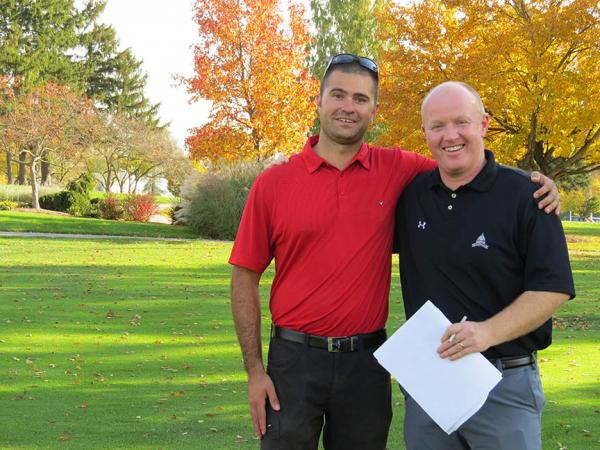 There are a lot of new faces at tradition-rich Ohio State Agricultural and Technical Institute.
There are a lot of new faces at tradition-rich Ohio State Agricultural and Technical Institute.Located in Wooster in northeastern Ohio, ATI has been serving students for decades. Today, that heritage is being ushered into the future by Ed Nangle, Ph.D., and Zane Raudenbush, Ph.D. Both are faced with the challenge of providing students with a two-year crash course that prepares them to work at any golf course or athletic field complex in the country.
Nangle joined ATI in August after three years as the agronomist for the Chicago District Golf Association and its 400 member courses that span five Midwestern States.
"I came here to ATI because I saw a lot of potential in it," Nangle said. "It's one of the few two-year programs in turf, and there is a huge potential to create something that offers value.
"Here, we have the opportunity to combine something quicker on the turnover with an opportunity for kids to start their career."
There is no mistaking that golf is at a crossroads. Demand is down as golfers continue a decade-long trend of fleeing the game at a stunning pace. In response, courses continue to close, taking with them hundreds of jobs.
It is a time of reckoning for those who train turf students as well, and who, despite the contraction of the golf industry, are having a hard time keeping up with the demand for would-be turfgrass managers.
Ohio State Agricultural and Technical Institute has been offering associate's degrees in turfgrass management for decades. Today, the calls coming into ATI begging for its graduates outnumber the two-dozen or so students enrolled in the program.
Declining interest in the game might partially explain why demand for turf managers outnumbers supply, even while golf is in decline, says Raudenbush, assistant professor of turfgrass science at Ohio State ATI since January.
"How do you really get interested in being a golf course superintendent if you've never been around a golf course, never played the game or appreciate what it's about? What gets you in the door there?" asked Raudenbush, a Rutgers graduate who worked for John Zimmers at Oakmont Golf Club from 2004 to 2007 before moving on to Kansas State where he earned master's and doctorate degrees.
"Sports turf is still growing. The jobs are there, and the students are more aware of those positions. What the golf industry needs is trained technical people, spray techs and mechanics."
Providing highly trained graduates with a solid foundation in technical know-how is what ATI, and other two-year programs, specialize in.
"What we offer is practical experience. We get our graduates out and working and interacting," Nangle said. "Applied learning has always been strong here, and it always will be."
Applied learning has always been strong here, and it always will be."
Opened in 1969, ATI is home to 700 students, and, according to Ohio State, is the largest two-year satellite campus in the country.
"Students here get real practical education and skills," Raudenbush said.
"You can only teach them so much in two years. I tell them they'll only learn 20 to 30 percent of what they need to know in school. The rest they'll learn on the job. The question to ask is where is a two-year graduate after four years, compared with a four-year graduate after four years."
ATI provides several hands-on learning experiences, including a putting green built in the 1970s by John Street, Ph.D., ballfields, a mixing bay, a fleet of equipment, two new grinders and access to Hawk's Nest Golf Course.
The latter, which was donated to the school by its former owners, includes a bentgrass research green and an off-campus classroom, both for ATI students. The ATI experience also includes an internship, but not just any internship, Nangle said.
"I don't want to just tell someone they have to go somewhere for an internship. I want to know what they offer for housing, meals, clothing, and is there an actual learning process?" Nangle said. "I want to know what they'll be doing in one month, what's going on in month 2 and what is going on in month 3. Then we can show them what is going to happen, and it starts to sell itself."
ATI is long on practical education and training, but, lacks some of the other academic offerings associated with four-year programs. That ability to get through school and into the workplace in short order was one of the reasons Brett Bentley, superintendent at Pikewood National Golf Club in Morgantown, W.Va., chose ATI 18 years ago.
A native of Salem in northeastern Ohio, Bentley interned for Matt Shaffer and went on to work at Oakmont under Zimmers, himself a graduate of Rutgers' two-year program.
"I wanted to go to a two-year school so I could get out quicker and get to work," Bentley said.
"A lot of the work was hands on - running equipment, sharpening reels and calibrating equipment."
Although students at ATI can hit the workforce in half the time as those seeking a four-year degree, no corners are cut at this northeastern Ohio campus.
"We need to get students excited about these opportunities and the ability to make a solid income," Nangle said.
"Kids also have to understand that nothing is handed to them. One thing we don't do is sugarcoat things. This is a great industry, but it's not an easy one. If it was, everyone would do it."

